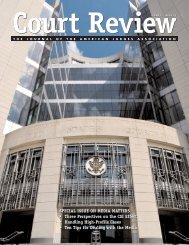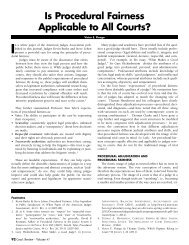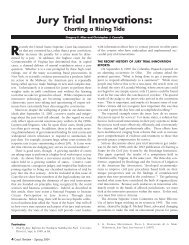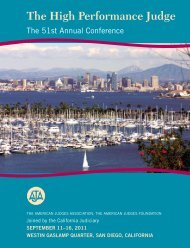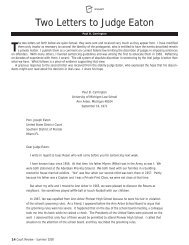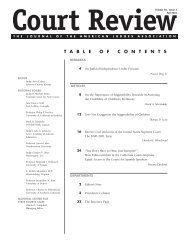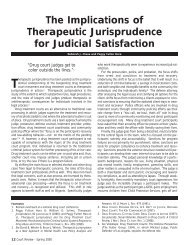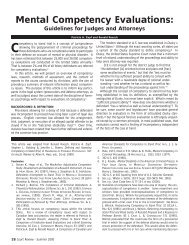Special Issue on Procedural Fairness - American Judges Association
Special Issue on Procedural Fairness - American Judges Association
Special Issue on Procedural Fairness - American Judges Association
- No tags were found...
You also want an ePaper? Increase the reach of your titles
YUMPU automatically turns print PDFs into web optimized ePapers that Google loves.
gThe Resource PageoAN ONLINE COURSE:OPINION WRITINGIN CONTROVERSIAL CASEShttp://www.ncsc<strong>on</strong>line.org/opini<strong>on</strong>writing/One of the keys to procedural fairness ismaking sure that a judge’s order is understoodand the reas<strong>on</strong>s for the decisi<strong>on</strong> areunderstood too. This can be especiallydifficult in a c<strong>on</strong>troversial case in whichemoti<strong>on</strong>s are running high and understandingmay run low.The Nati<strong>on</strong>al Center for State Courts,working with the Missouri Judiciary, hasprepared an <strong>on</strong>line course <strong>on</strong> “Opini<strong>on</strong>Writing in C<strong>on</strong>troversial Cases.” We allknow that trial judges can face high-profilecases that suddenly appear <strong>on</strong> thedocket and explode into the public’s interest.The United States Supreme Court’sdecisi<strong>on</strong> in Kelo v. City of New L<strong>on</strong>d<strong>on</strong>,545 U.S. 469 (2005) (upholding use ofeminent domain powers for ec<strong>on</strong>omicdevelopment) showed that this is true atthe appellate level as well. There actuallywas a short-term drop in public opini<strong>on</strong>of the Court after the Kelo decisi<strong>on</strong>.This <strong>on</strong>line course discusses Keloas wellas more typical cases. The first part ofthe course is a video discussi<strong>on</strong> betweenMissouri Chief Justice Laura Stith andMissouri Court of Appeals Judge R<strong>on</strong>aldHolliger <strong>on</strong> the changing c<strong>on</strong>text inwhich judicial opini<strong>on</strong>s are beingreported in the media, in which judicialopini<strong>on</strong>s feed into ec<strong>on</strong>omic, political,and social c<strong>on</strong>troversies. The sec<strong>on</strong>dpart of the course is a <strong>on</strong>e-hour videolecture from Professor Nancy Wanderer,a law professor at the University ofMaine. She presents an approach forwriting opini<strong>on</strong>s and orders in c<strong>on</strong>troversial,high-profile cases. The third partof the course is a web-based seminar ledby Professor Wanderer and retiredWashingt<strong>on</strong> Superior Court JudgeRobert H. Alsdorf; they build <strong>on</strong>Professor Wanderer’s lecture and leadparticipants through an interactive critiqueof judicial opini<strong>on</strong>s in selectedcases, including Kelo. The final part ofthe course gives participants an opportunityto practice some of the techniquesand even to receive faculty feedback <strong>on</strong>submitted opini<strong>on</strong>-writing samples.There are lots of <strong>on</strong>line materialsincluded with the course, al<strong>on</strong>g with thevideo discussi<strong>on</strong>s and lectures, the interactiveseminar, and the practice exercises.CALIFORNIA COURTS WEBSITE ONPROCEDURAL FAIRNESShttp://www.courtinfo.ca.gov/programs/profair/In September 2007, when the <strong>American</strong><strong>Judges</strong> Associati<strong>on</strong> unveiled its WhitePaper <strong>on</strong> procedural fairness, theCalifornia court system simultaneouslylaunched its own procedural-fairness initiative.The AJA and the Californiacourts have shared our work, and we’repleased to note that the California courtshave a permanent website devoted totracking their initiatives in this area andresources that may be helpful to all interestedjudges.Doug Dent<strong>on</strong>’s article in this issue (page44) discusses the work already underwayin California. The effort there is ambitious,creative, and <strong>on</strong>going. Dent<strong>on</strong>described the California court system as“<strong>on</strong>e of the most innovative” in theUnited States; we agree. And certainly nocourt system is more involved at presentin efforts to improve procedural fairness—andthe public’s percepti<strong>on</strong> of fairness—thanthe California court system is.California has prepared tools that can beused in judicial workshops, such as thetemplate found <strong>on</strong> page 46. AJA presentershave used that template in workshopsin other states. We suggest youcheck the California website <strong>on</strong> proceduralfairness periodically to find newresources and updated informati<strong>on</strong> <strong>on</strong>this topic.RESOURCES ONPROBLEM-SOLVING JUSTICENati<strong>on</strong>al Center for State Courtshttp://www.ncsc<strong>on</strong>line.org/WC/CourTopics/ResourceGuide.asp?topic=ProSolCenter for Court Innovati<strong>on</strong>http://www.courtinnovati<strong>on</strong>.org/index.cfm?fuseacti<strong>on</strong>=page.viewPage&pageID=505&documentTopicID=31Nati<strong>on</strong>al Judicial Institute (of Canada)http://www.nji.ca/nji/Public/documents/Judgingfor21scenturyDe.pdfInternati<strong>on</strong>al Network <strong>on</strong> TherapeuticJurisprudencehttp://www.therapeuticjurisprudence.orgWhatever difference there may bebetween what some call problem-solvingjustice and what others call therapeuticjurisprudence, there is sufficient overlapbetween those c<strong>on</strong>cepts and proceduralfairness that any<strong>on</strong>e interested in any ofthose topics will find in the websites welist here of interest. The Nati<strong>on</strong>al Centerfor State Courts has extensive web-basedresources <strong>on</strong> problem-solving justice,including the Problem-Solving Justicetoolkit, an interactive resource for findingsoluti<strong>on</strong>s to problems your courtmay face. New York’s Center for CourtInnovati<strong>on</strong> also has a useful website, fullof links, fact sheets, and self-assessmenttools.Professor David Wexler points to twoother resources in his article in this issue(page 74). One is a site he updates calledthe Internati<strong>on</strong>al Network <strong>on</strong> TherapeuticJurisprudence. The other is from theNati<strong>on</strong>al Judicial Institute of Canada: a61-page m<strong>on</strong>ograph entitled Judging forthe 21 st Century: A Problem-SolvingApproach. This m<strong>on</strong>ograph combinesmuch of Professor Wexler’s therapeuticjurisprudence material with a discussi<strong>on</strong>of ways in which a judge may improve hisor her skills in procedural fairness in areassuch as empathy, respect, active listening,positive focus, clarity, avoiding coerci<strong>on</strong>,and avoiding paternalism.84 Court Review - Volume 44



